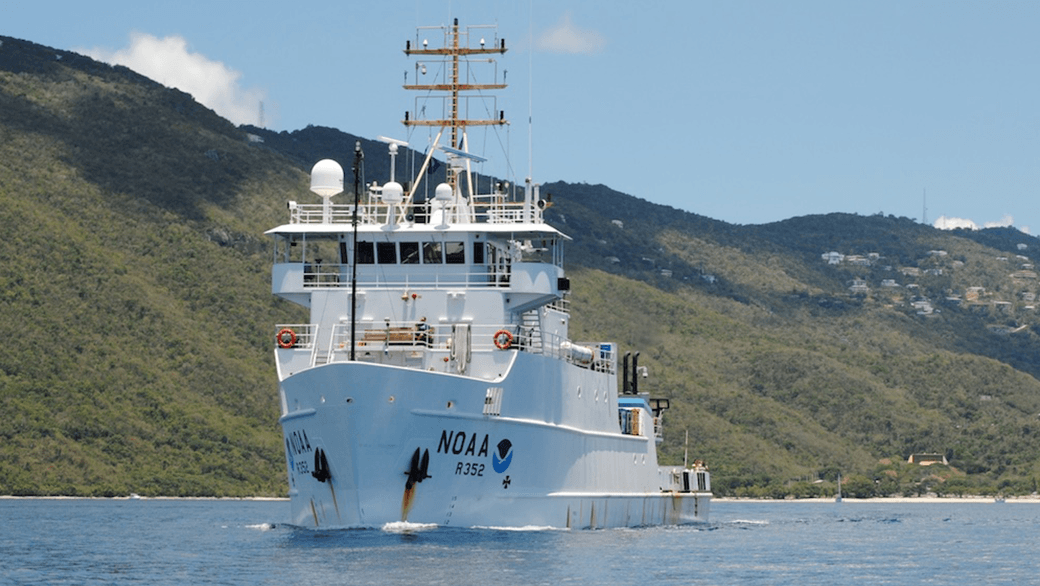AOML is partnering with NOAA’s Southeast Fisheries Science Center (SEFSC) to conduct an interdisciplinary research cruise aboard the NOAA Ship Nancy Foster from April 11, 2015 through June 3, 2015. The cruise will begin in the U.S. Virgin Islands and extend westward across the northern Caribbean conducting various biological and physical oceanographic surveys.
Leg 1: U.S. Virgin Islands
During the first leg of the cruise, NOAA oceanographers surveyed reef fish populations and ocean currents in the U.S. Virgin Islands. In particular, research focused on the Virgin Islands coastal shelf ecosystem where data collected will provide insight into the processes that drive spawning aggregations of economically important reef fish species in the region. Results from the expedition should also enhance scientists’ understanding of the differences in larval reef fish distributions between managed and non-managed areas of the coastal shelf. Armed with the data and accompanying knowledge of where “hot spots” of species richness and diversity are likely to occur in the seascape, the scientists are in a unique position to inform resource managers about the effectiveness of various approaches to managing living resources in the coastal shelf.
The reef fish larvae surveys involve casting a large net behind the vessel for 10-minute intervals. Scientists use a special kind of net known as a MOCNESS, which is a much-improved, high-tech version of the average sampling net. The letters in MOCNESS refer to the specific improvements: it’s a Multiple Opening and Closing Net, with an Environmental Sensing System. As MOCNESS tows behind the ship, each net can be opened and shut independently so that it samples a discrete patch of water. By using the environmental sensing system, the researcher can pinpoint exactly when and where to deploy the net. The sensing system is made up of an array of sensors mounted on the instrument frame that relays water conditions up to the ship in real time. The data also help researchers match what they find in their sample to the physical properties of the seawater.
After retrieving the nets, the contents are brought to the on board lab where scientists sample and document the species of fish. Scientists classified about 25,000 fish during each survey. This survey will build upon previous surveys conducted between 2007 and 2014, the resulting data of which is still being analyzed and studied. That data helps create a baseline for researchers to compare with new results. The long-term sustainability of fisheries in these banks will depend on the understanding of the transport, spawning aggregations and overall larval recruitment in these waters.
Aside from conducting surveys, NOAA oceanographers also participated in outreach opportunities with the local community. Students from Charlotte Amalie High School on St. Thomas toured the Nancy Foster and learned about the importance of larval reef fish. They even had a chance to examine larval specimens under a stereo-microscope and got a lesson in fish identification and classification.
Leg 2: Northern Caribbean
The second leg of the cruise began April 27th from Montego Bay, Jamaica and will take the team westward across the northern Caribbean, concluding in Cozumel, Mexico on May 5th. The biological focus of the research will shift from larval reef fish to the larvae of the pelagic Atlantic Bluefin Tuna. Oceanographers will continue to use the MOCNESS to collect their samples. Measurements and samples collected will provide species abundance and distribution data, and will help to improve tuna stock assessments for the western Caribbean Sea and Gulf of Mexico. The results will also be used to further develop a regional larval habitat model for Atlantic Bluefin Tuna.
Leg 3: Mexico/Mesoamerican Barrier Reef System
The third leg of the cruise began May 9th from Cozumel, Mexico. Oceanographers sampled along the Mesoamerican Barrier Reef System, the 2nd largest reef in the world, in an effort to learn more about the ecology and oceanography of this extremely diverse region. In this part of the Mesoamerican Barrier Reef, the rapidly moving Yucatan Current comes very close to shore, transporting fish larvae and other creatures. During this leg of the cruise, the focus on larval tuna continues but researchers will also sample larval lobster in an effort to measure species abundance and distribution data in the Mexican Caribbean.
In addition to NOAA participants, scientific collaborators from the University of Miami, the University of South Florida, the University of the Virgin Islands, the University of Oregon, the University of Puerto Rico, the University of the West Indies (Jamaica), the Department of Natural Resources (St. Thomas), the Colegio de la Frontera Sur (Mexico), the Instituto Nacional de Pesca (Mexico), and the Instituto Espanol de Oceanografia (Spain) will participate aboard the Nancy Foster as part of this interdisciplinary, multi-institutional, and international research cruise.
Originally Published in April 2015 by Edward Pritchard
Panoramic sunset of the island of St. Thomas taken aboard the Nancy Foster. Image Credit: NOAA
Small Atlantic bluefin tuna larvae collected on the Mesoamerican Barrier Reef. Image Credit: NOAA
The track of the Nancy Foster through the U.S. Virgin Islands over the course of Leg 1.
Image Credit: NOAA
A translucent larval parrotfish under the microscope. Image Credit: NOAA
The Nancy Foster team deploys the MOCNESS net during Leg 2 in the northern Caribbean. Image Credit: NOAA
The NOAA ship Nancy Foster in St. Thomas, U.S. Virgin Islands. Image Credit: NOAA
